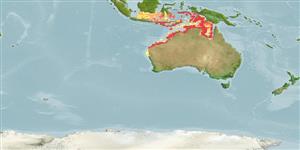Environment: milieu / climate zone / depth range / distribution range
Ecología
marino asociado a arrecife; rango de profundidad 5 - 50 m (Ref. 90102). Tropical; 3°S - 27°S, 109°E - 141°E (Ref. 3810)
Distribución
Países | Áreas FAO | Ecosistemas | Ocurrencias, apariciones | Point map | Introducciones | Faunafri
Eastern Indian Ocean: Aru Islands (Indonesia) and northwest Australia. This species closely resembles Pentapodus setosus and Pentapodus paradiseus.
Tamaño / Peso / Age
Maturity: Lm ? range ? - ? cm
Max length : 27.0 cm TL macho / no sexado; (Ref. 9710); common length : 15.0 cm SL macho / no sexado; (Ref. 3810)
Espinas dorsales (total) : 10; Radios blandos dorsales (total) : 9; Espinas anales: 3; Radios blandos anales: 7. Head scales reaching forward to or almost to level of posterior nostrils. Suborbital naked. Lower limb of preopercle naked. Pelvic fins short, not reaching near level of anus. Upper and lower lobes of caudal fin pointed, more or less equal in length. Axillary scale present. Color: Upper body pale brownish, lower whitish. Presence of three bluish stripes across snout, first joining eyes behind nostrils, second in front of nostrils, third from eye to tip of snout. A yellow stripe from behind eye to upper base of pectoral fin and another running from middle of upper lip.
Occurs close to reefs in offshore waters (Ref. 9785). Solitary or small groups (Ref. 90102).
Life cycle and mating behavior
Maturities | Reproducción | Spawnings | Egg(s) | Fecundities | Larva
Russell, B.C., 1990. FAO Species Catalogue. Vol. 12. Nemipterid fishes of the world. (Threadfin breams, whiptail breams, monocle breams, dwarf monocle breams, and coral breams). Family Nemipteridae. An annotated and illustrated catalogue of nemipterid species known to date. FAO Fish. Synop. 125(12):149p. Rome: FAO. (Ref. 3810)
IUCN Red List Status (Ref. 130435)
Threat to humans
Harmless
Human uses
Pesquerías: pesquerías de subsistencia
Herramientas
Special reports
Download XML
Fuentes de Internet
Estimates based on models
Preferred temperature (Ref.
123201): 26.4 - 28.7, mean 27.9 °C (based on 182 cells).
Phylogenetic diversity index (Ref.
82804): PD
50 = 0.5002 [Uniqueness, from 0.5 = low to 2.0 = high].
Bayesian length-weight: a=0.01479 (0.00706 - 0.03101), b=2.97 (2.80 - 3.14), in cm total length, based on LWR estimates for this (Sub)family-body shape (Ref.
93245).
Nivel trófico (Ref.
69278): 3.6 ±0.5 se; based on size and trophs of closest relatives
Resiliencia (Ref.
120179): Alto, población duplicada en un tiempo mínimo inferior a 15 meses (Preliminary K or Fecundity.).
Fishing Vulnerability (Ref.
59153): Low vulnerability (17 of 100).
Nutrients (Ref.
124155): Calcium = 57.7 [35.1, 116.1] mg/100g; Iron = 0.656 [0.321, 1.603] mg/100g; Protein = 19.1 [17.2, 20.8] %; Omega3 = 0.155 [0.093, 0.259] g/100g; Selenium = 29.7 [17.8, 53.1] μg/100g; VitaminA = 78.1 [22.6, 222.5] μg/100g; Zinc = 1.24 [0.86, 1.78] mg/100g (wet weight);
